service indicator Alfa Romeo Giulia 2018 Owner's Manual
[x] Cancel search | Manufacturer: ALFA ROMEO, Model Year: 2018, Model line: Giulia, Model: Alfa Romeo Giulia 2018Pages: 260, PDF Size: 6 MB
Page 56 of 260
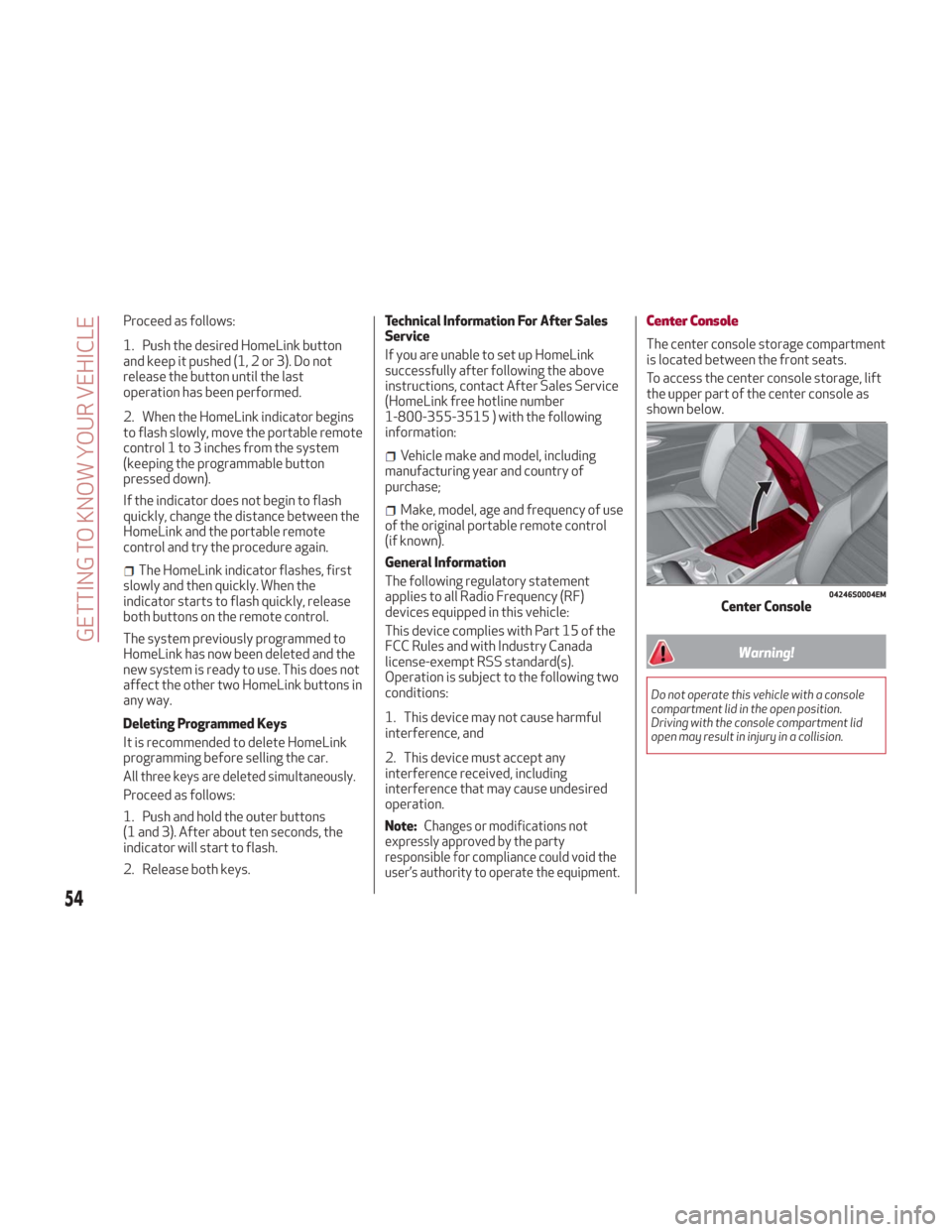
Proceed as follows:
1. Push the desired HomeLink button
and keep it pushed (1, 2 or 3). Do not
release the button until the last
operation has been performed.
2. When the HomeLink indicator begins
to flash slowly, move the portable remote
control 1 to 3 inches from the system
(keeping the programmable button
pressed down).
If the indicator does not begin to flash
quickly, change the distance between the
HomeLink and the portable remote
control and try the procedure again.
The HomeLink indicator flashes, first
slowly and then quickly. When the
indicator starts to flash quickly, release
both buttons on the remote control.
The system previously programmed to
HomeLink has now been deleted and the
new system is ready to use. This does not
affect the other two HomeLink buttons in
any way.
Deleting Programmed Keys
It is recommended to delete HomeLink
programming before selling the car.
All three keys are deleted simultaneously.
Proceed as follows:
1. Push and hold the outer buttons
(1 and 3). After about ten seconds, the
indicator will start to flash.
2. Release both keys. Technical Information For After Sales
Service
If you are unable to set up HomeLink
successfully after following the above
instructions, contact After Sales Service
(HomeLink free hotline number
1-800-355-3515 ) with the following
information:
Vehicle make and model, including
manufacturing year and country of
purchase;
Make, model, age and frequency of use
of the original portable remote control
(if known).
General Information
The following regulatory statement
applies to all Radio Frequency (RF)
devices equipped in this vehicle:
This device complies with Part 15 of the
FCC Rules and with Industry Canada
license-exempt RSS standard(s).
Operation is subject to the following two
conditions:
1. This device may not cause harmful
interference, and
2. This device must accept any
interference received, including
interference that may cause undesired
operation.
Note:
Changes or modifications not
expressly approved by the party
responsible for compliance could void the
user’s authority to operate the equipment.
Center Console
The center console storage compartment
is located between the front seats.
To access the center console storage, lift
the upper part of the center console as
shown below.
Warning!
Do not operate this vehicle with a console
compartment lid in the open position.
Driving with the console compartment lid
open may result in injury in a collision.
04246S0004EMCenter Console
54
GETTING TO KNOW YOUR VEHICLE
Page 70 of 260
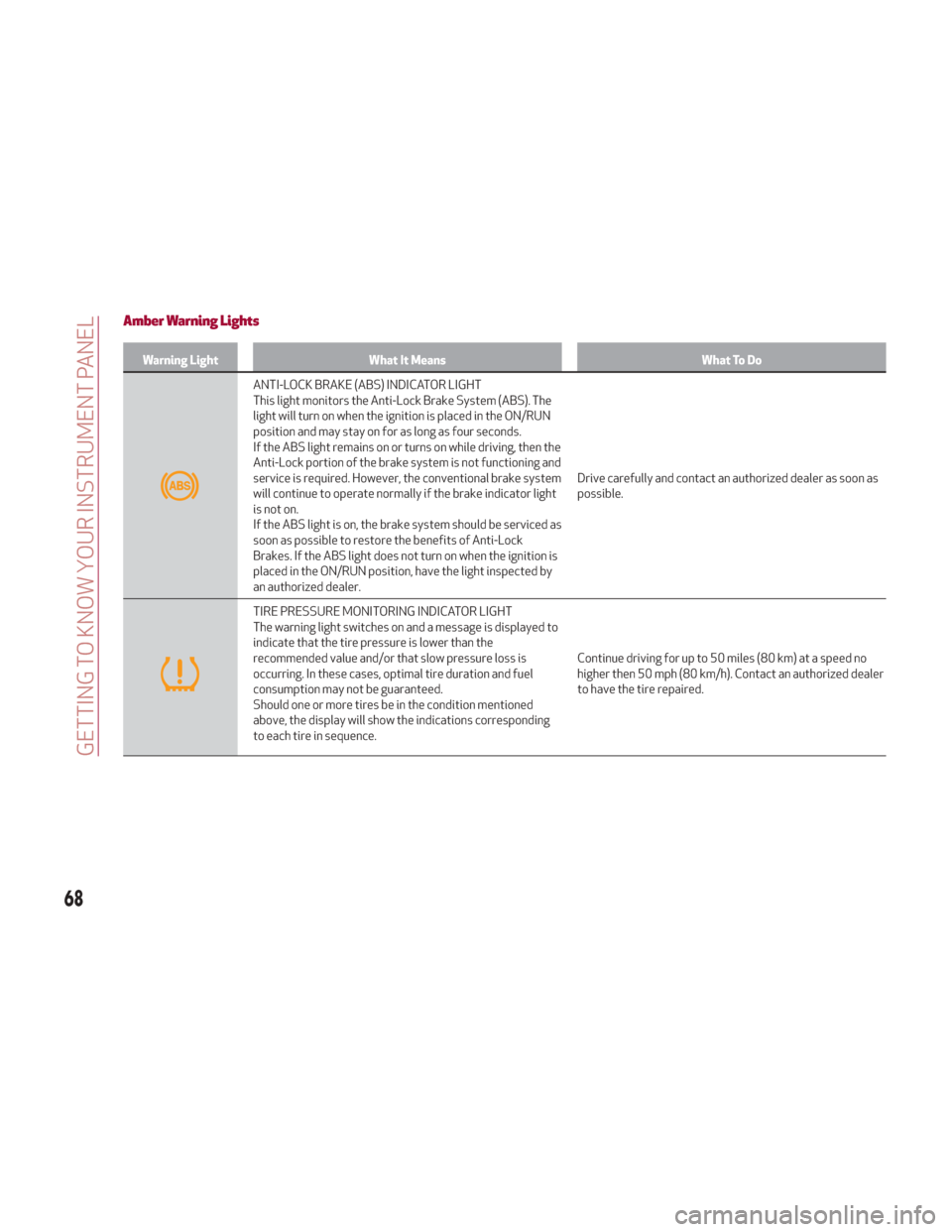
Amber Warning Lights
Warning LightWhat It Means What To Do
ANTI-LOCK BRAKE (ABS) INDICATOR LIGHT
This light monitors the Anti-Lock Brake System (ABS). The
light will turn on when the ignition is placed in the ON/RUN
position and may stay on for as long as four seconds.
If the ABS light remains on or turns on while driving, then the
Anti-Lock portion of the brake system is not functioning and
service is required. However, the conventional brake system
will continue to operate normally if the brake indicator light
is not on.
If the ABS light is on, the brake system should be serviced as
soon as possible to restore the benefits of Anti-Lock
Brakes. If the ABS light does not turn on when the ignition is
placed in the ON/RUN position, have the light inspected by
an authorized dealer.Drive carefully and contact an authorized dealer as soon as
possible.
TIRE PRESSURE MONITORING INDICATOR LIGHT
The warning light switches on and a message is displayed to
indicate that the tire pressure is lower than the
recommended value and/or that slow pressure loss is
occurring. In these cases, optimal tire duration and fuel
consumption may not be guaranteed.
Should one or more tires be in the condition mentioned
above, the display will show the indications corresponding
to each tire in sequence.
Continue driving for up to 50 miles (80 km) at a speed no
higher then 50 mph (80 km/h). Contact an authorized dealer
to have the tire repaired.
68
GETTING TO KNOW YOUR INSTRUMENT PANEL
Page 88 of 260
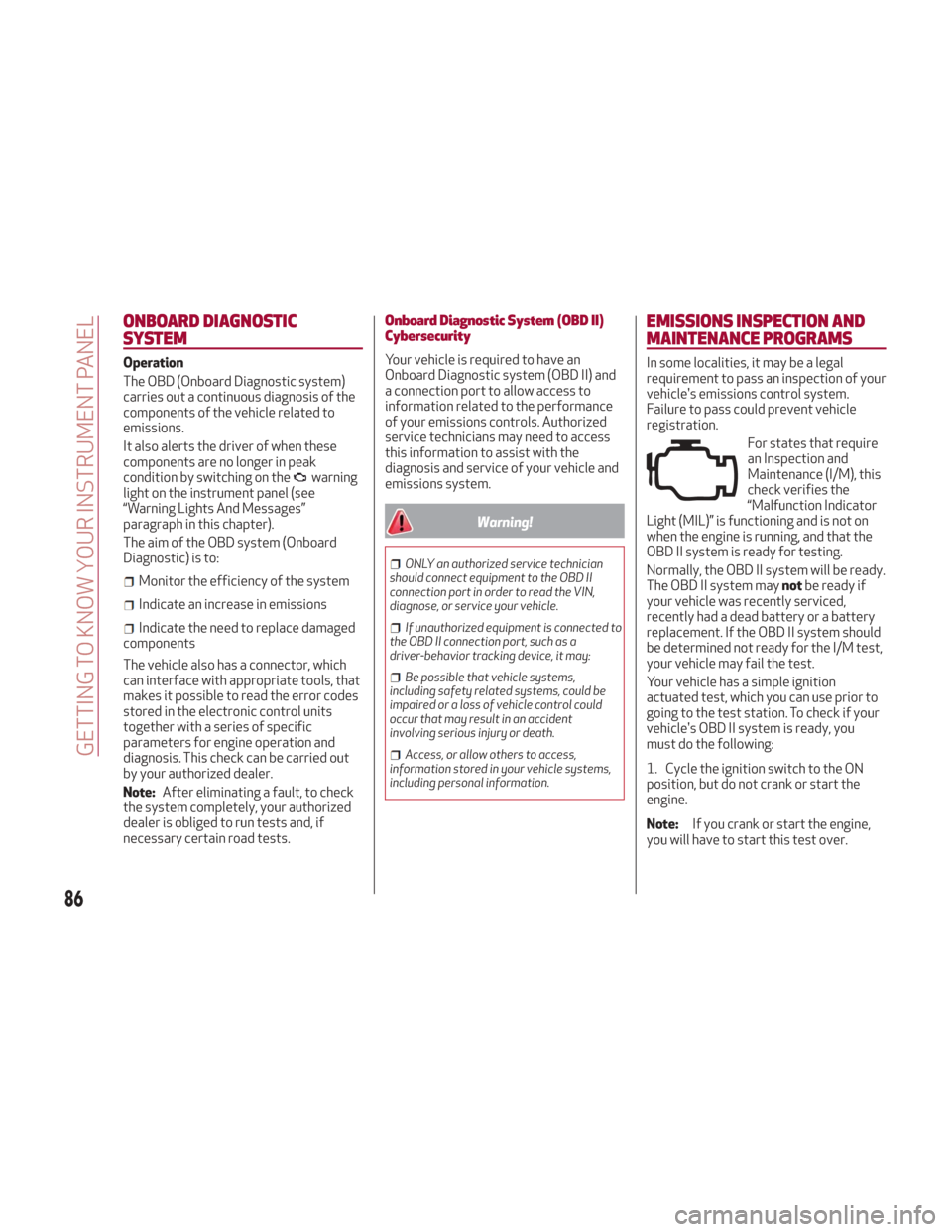
ONBOARD DIAGNOSTIC
SYSTEM
Operation
The OBD (Onboard Diagnostic system)
carries out a continuous diagnosis of the
components of the vehicle related to
emissions.
It also alerts the driver of when these
components are no longer in peak
condition by switching on the
warning
light on the instrument panel (see
“Warning Lights And Messages”
paragraph in this chapter).
The aim of the OBD system (Onboard
Diagnostic) is to:
Monitor the efficiency of the system
Indicate an increase in emissions
Indicate the need to replace damaged
components
The vehicle also has a connector, which
can interface with appropriate tools, that
makes it possible to read the error codes
stored in the electronic control units
together with a series of specific
parameters for engine operation and
diagnosis. This check can be carried out
by your authorized dealer.
Note: After eliminating a fault, to check
the system completely, your authorized
dealer is obliged to run tests and, if
necessary certain road tests.
Onboard Diagnostic System (OBD II)
Cybersecurity
Your vehicle is required to have an
Onboard Diagnostic system (OBD II) and
a connection port to allow access to
information related to the performance
of your emissions controls. Authorized
service technicians may need to access
this information to assist with the
diagnosis and service of your vehicle and
emissions system.
Warning!
ONLY an authorized service technician
should connect equipment to the OBD II
connection port in order to read the VIN,
diagnose, or service your vehicle.
If unauthorized equipment is connected to
the OBD II connection port, such as a
driver-behavior tracking device, it may:
Be possible that vehicle systems,
including safety related systems, could be
impaired or a loss of vehicle control could
occur that may result in an accident
involving serious injury or death.
Access, or allow others to access,
information stored in your vehicle systems,
including personal information.
EMISSIONS INSPECTION AND
MAINTENANCE PROGRAMS
In some localities, it may be a legal
requirement to pass an inspection of your
vehicle's emissions control system.
Failure to pass could prevent vehicle
registration.
For states that require
an Inspection and
Maintenance (I/M), this
check verifies the
“Malfunction Indicator
Light (MIL)” is functioning and is not on
when the engine is running, and that the
OBD II system is ready for testing.
Normally, the OBD II system will be ready.
The OBD II system may notbe ready if
your vehicle was recently serviced,
recently had a dead battery or a battery
replacement. If the OBD II system should
be determined not ready for the I/M test,
your vehicle may fail the test.
Your vehicle has a simple ignition
actuated test, which you can use prior to
going to the test station. To check if your
vehicle's OBD II system is ready, you
must do the following:
1. Cycle the ignition switch to the ON
position, but do not crank or start the
engine.
Note: If you crank or start the engine,
you will have to start this test over.
86
GETTING TO KNOW YOUR INSTRUMENT PANEL
Page 89 of 260
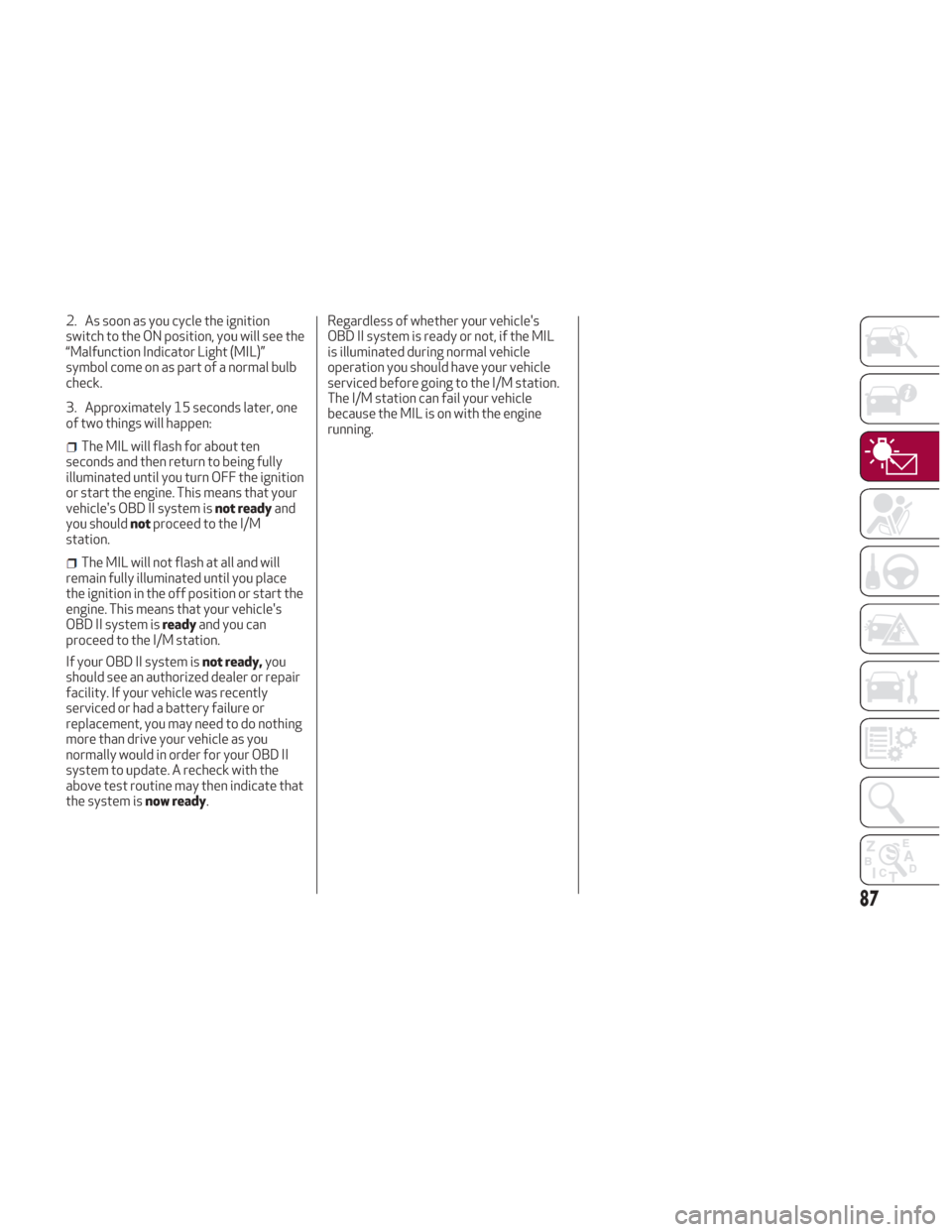
2. As soon as you cycle the ignition
switch to the ON position, you will see the
“Malfunction Indicator Light (MIL)”
symbol come on as part of a normal bulb
check.
3. Approximately 15 seconds later, one
of two things will happen:
The MIL will flash for about ten
seconds and then return to being fully
illuminated until you turn OFF the ignition
or start the engine. This means that your
vehicle's OBD II system is not readyand
you should notproceed to the I/M
station.
The MIL will not flash at all and will
remain fully illuminated until you place
the ignition in the off position or start the
engine. This means that your vehicle's
OBD II system is readyand you can
proceed to the I/M station.
If your OBD II system is not ready,you
should see an authorized dealer or repair
facility. If your vehicle was recently
serviced or had a battery failure or
replacement, you may need to do nothing
more than drive your vehicle as you
normally would in order for your OBD II
system to update. A recheck with the
above test routine may then indicate that
the system is now ready. Regardless of whether your vehicle's
OBD II system is ready or not, if the MIL
is illuminated during normal vehicle
operation you should have your vehicle
serviced before going to the I/M station.
The I/M station can fail your vehicle
because the MIL is on with the engine
running.
87
Page 196 of 260
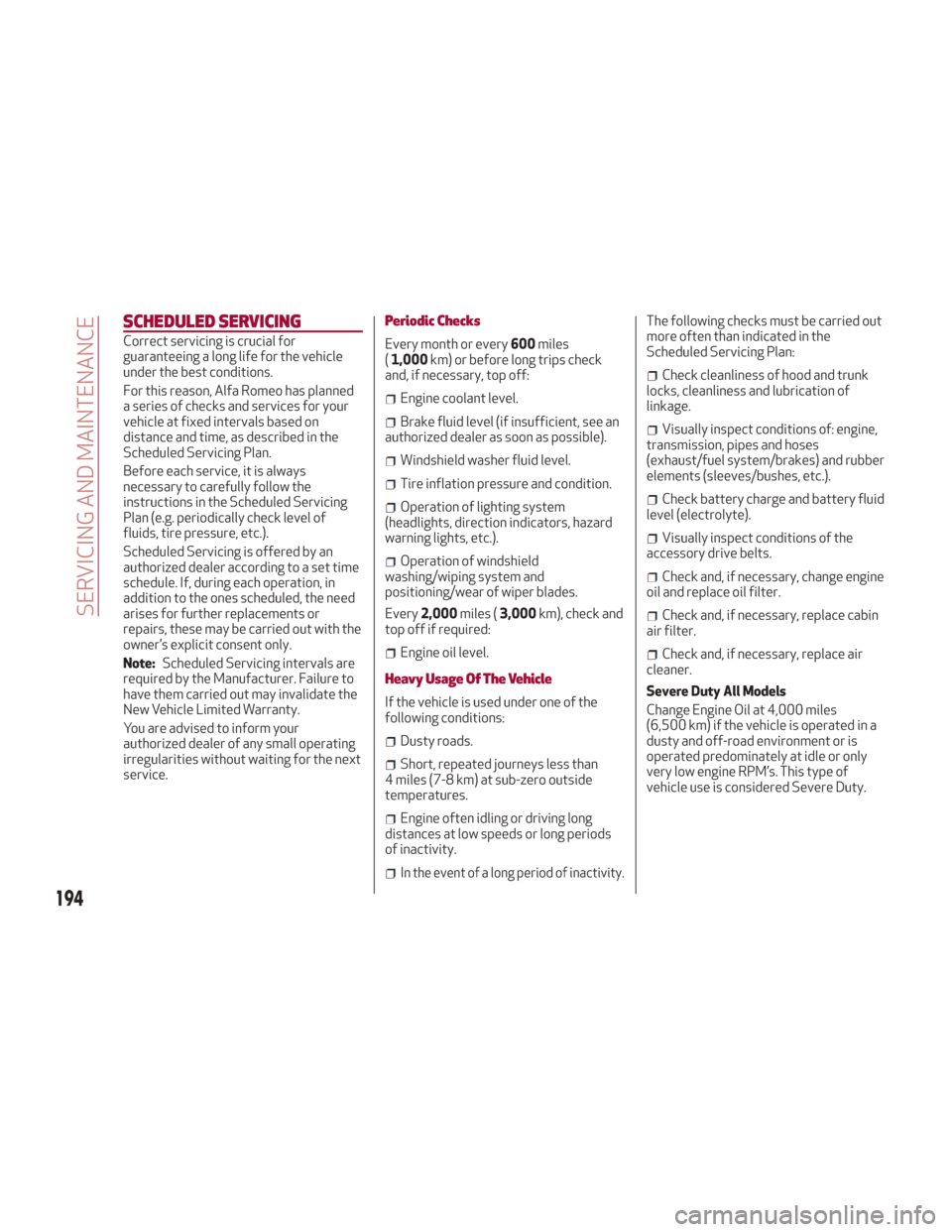
SCHEDULED SERVICING
Correct servicing is crucial for
guaranteeing a long life for the vehicle
under the best conditions.
For this reason, Alfa Romeo has planned
a series of checks and services for your
vehicle at fixed intervals based on
distance and time, as described in the
Scheduled Servicing Plan.
Before each service, it is always
necessary to carefully follow the
instructions in the Scheduled Servicing
Plan (e.g. periodically check level of
fluids, tire pressure, etc.).
Scheduled Servicing is offered by an
authorized dealer according to a set time
schedule. If, during each operation, in
addition to the ones scheduled, the need
arises for further replacements or
repairs, these may be carried out with the
owner’s explicit consent only.
Note:Scheduled Servicing intervals are
required by the Manufacturer. Failure to
have them carried out may invalidate the
New Vehicle Limited Warranty.
You are advised to inform your
authorized dealer of any small operating
irregularities without waiting for the next
service.
Periodic Checks
Every month or every 600miles
( 1,000 km) or before long trips check
and, if necessary, top off:
Engine coolant level.
Brake fluid level (if insufficient, see an
authorized dealer as soon as possible).
Windshield washer fluid level.
Tire inflation pressure and condition.
Operation of lighting system
(headlights, direction indicators, hazard
warning lights, etc.).
Operation of windshield
washing/wiping system and
positioning/wear of wiper blades.
Every 2,000 miles ( 3,000km), check and
top off if required:
Engine oil level.
Heavy Usage Of The Vehicle
If the vehicle is used under one of the
following conditions:
Dusty roads.
Short, repeated journeys less than
4 miles (7-8 km) at sub-zero outside
temperatures.
Engine often idling or driving long
distances at low speeds or long periods
of inactivity.
In the event of a long period of inactivity.
The following checks must be carried out
more often than indicated in the
Scheduled Servicing Plan:
Check cleanliness of hood and trunk
locks, cleanliness and lubrication of
linkage.
Visually inspect conditions of: engine,
transmission, pipes and hoses
(exhaust/fuel system/brakes) and rubber
elements (sleeves/bushes, etc.).
Check battery charge and battery fluid
level (electrolyte).
Visually inspect conditions of the
accessory drive belts.
Check and, if necessary, change engine
oil and replace oil filter.
Check and, if necessary, replace cabin
air filter.
Check and, if necessary, replace air
cleaner.
Severe Duty All Models
Change Engine Oil at 4,000 miles
(6,500 km) if the vehicle is operated in a
dusty and off-road environment or is
operated predominately at idle or only
very low engine RPM’s. This type of
vehicle use is considered Severe Duty.
194
SERVICING AND MAINTENANCE
Page 221 of 260
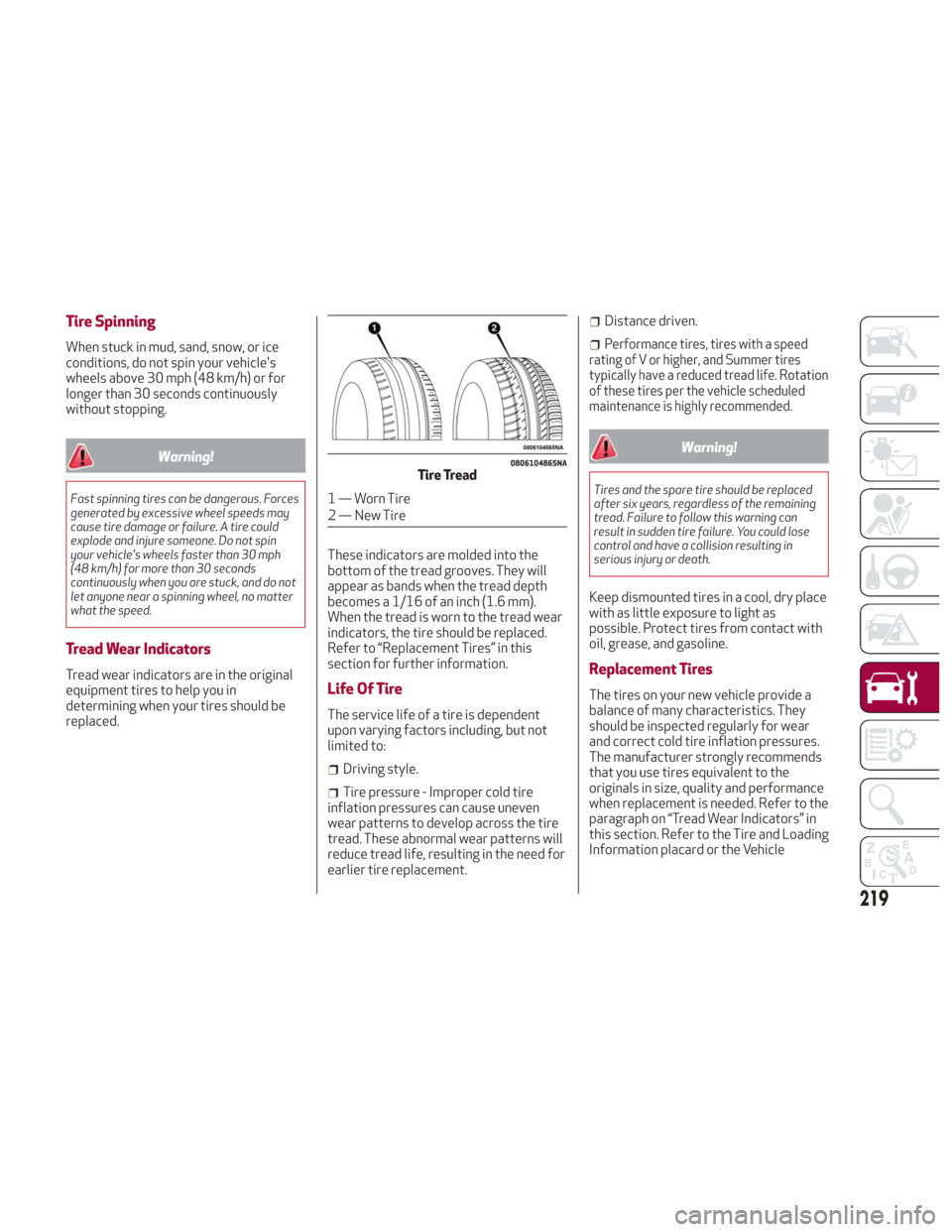
Tire Spinning
When stuck in mud, sand, snow, or ice
conditions, do not spin your vehicle's
wheels above 30 mph (48 km/h) or for
longer than 30 seconds continuously
without stopping.
Warning!
Fast spinning tires can be dangerous. Forces
generated by excessive wheel speeds may
cause tire damage or failure. A tire could
explode and injure someone. Do not spin
your vehicle's wheels faster than 30 mph
(48 km/h) for more than 30 seconds
continuously when you are stuck, and do not
let anyone near a spinning wheel, no matter
what the speed.
Tread Wear Indicators
Tread wear indicators are in the original
equipment tires to help you in
determining when your tires should be
replaced.These indicators are molded into the
bottom of the tread grooves. They will
appear as bands when the tread depth
becomes a 1/16 of an inch (1.6 mm).
When the tread is worn to the tread wear
indicators, the tire should be replaced.
Refer to “Replacement Tires” in this
section for further information.Life Of Tire
The service life of a tire is dependent
upon varying factors including, but not
limited to:
Driving style.
Tire pressure - Improper cold tire
inflation pressures can cause uneven
wear patterns to develop across the tire
tread. These abnormal wear patterns will
reduce tread life, resulting in the need for
earlier tire replacement.
Distance driven.
Performance tires, tires with a speed
rating of V or higher, and Summer tires
typically have a reduced tread life. Rotation
of these tires per the vehicle scheduled
maintenance is highly recommended.
Warning!
Tires and the spare tire should be replaced
after six years, regardless of the remaining
tread. Failure to follow this warning can
result in sudden tire failure. You could lose
control and have a collision resulting in
serious injury or death.
Keep dismounted tires in a cool, dry place
with as little exposure to light as
possible. Protect tires from contact with
oil, grease, and gasoline.
Replacement Tires
The tires on your new vehicle provide a
balance of many characteristics. They
should be inspected regularly for wear
and correct cold tire inflation pressures.
The manufacturer strongly recommends
that you use tires equivalent to the
originals in size, quality and performance
when replacement is needed. Refer to the
paragraph on “Tread Wear Indicators” in
this section. Refer to the Tire and Loading
Information placard or the Vehicle
0806104865NATire Tread
1 — Worn Tire
2 — New Tire
219
Page 241 of 260
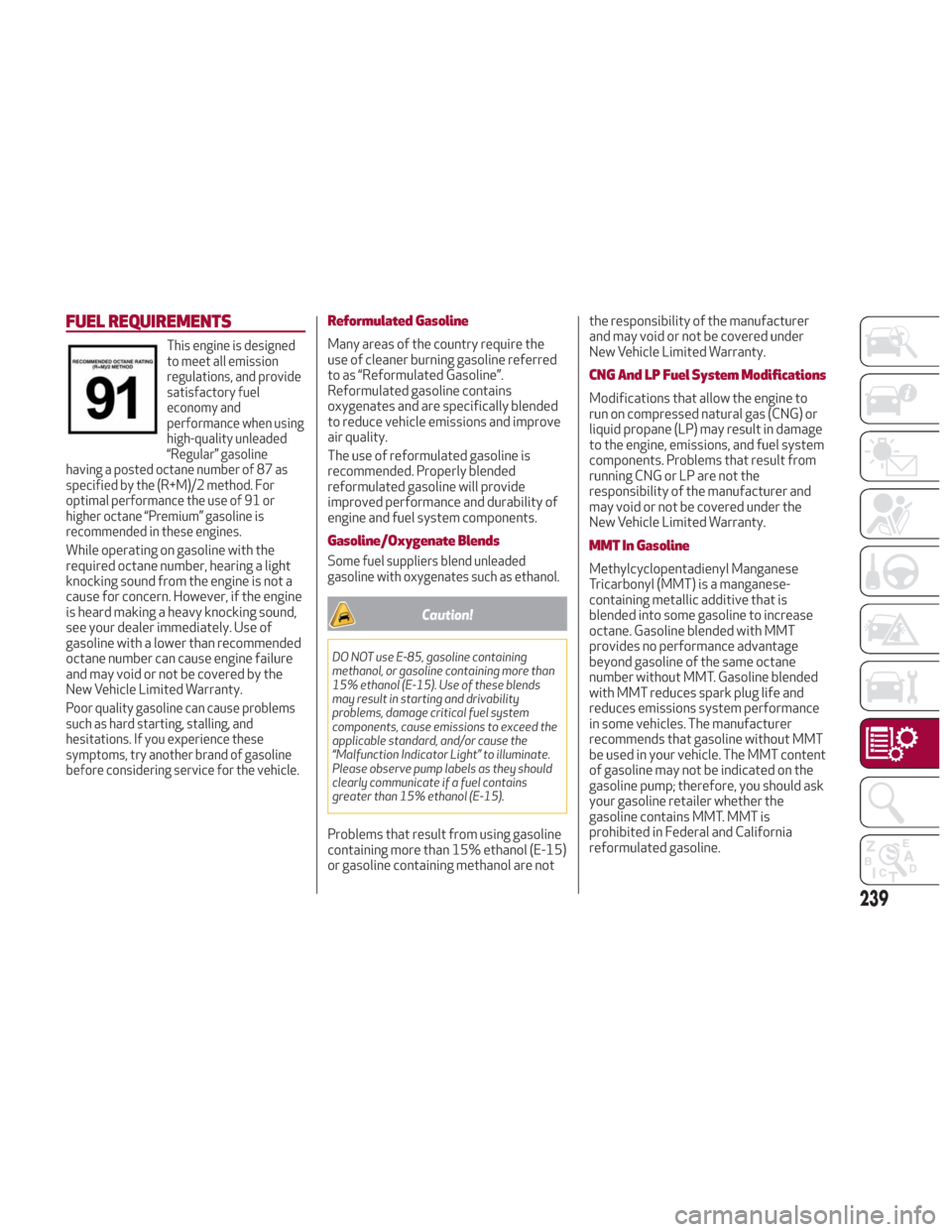
FUEL REQUIREMENTS
This engine is designed
to meet all emission
regulations, and provide
satisfactory fuel
economy and
performance when using
high-quality unleaded
“Regular” gasoline
having a posted octane number of 87 as
specified by the (R+M)/2 method. For
optimal performance the use of 91 or
higher octane “Premium” gasoline is
recommended in these engines.
While operating on gasoline with the
required octane number, hearing a light
knocking sound from the engine is not a
cause for concern. However, if the engine
is heard making a heavy knocking sound,
see your dealer immediately. Use of
gasoline with a lower than recommended
octane number can cause engine failure
and may void or not be covered by the
New Vehicle Limited Warranty.
Poor quality gasoline can cause problems
such as hard starting, stalling, and
hesitations. If you experience these
symptoms, try another brand of gasoline
before considering service for the vehicle.
Reformulated Gasoline
Many areas of the country require the
use of cleaner burning gasoline referred
to as “Reformulated Gasoline”.
Reformulated gasoline contains
oxygenates and are specifically blended
to reduce vehicle emissions and improve
air quality.
The use of reformulated gasoline is
recommended. Properly blended
reformulated gasoline will provide
improved performance and durability of
engine and fuel system components.
Gasoline/Oxygenate Blends
Some fuel suppliers blend unleaded
gasoline with oxygenates such as ethanol.
Caution!
DO NOT use E-85, gasoline containing
methanol, or gasoline containing more than
15% ethanol (E-15). Use of these blends
may result in starting and drivability
problems, damage critical fuel system
components, cause emissions to exceed the
applicable standard, and/or cause the
“Malfunction Indicator Light” to illuminate.
Please observe pump labels as they should
clearly communicate if a fuel contains
greater than 15% ethanol (E-15).
Problems that result from using gasoline
containing more than 15% ethanol (E-15)
or gasoline containing methanol are not the responsibility of the manufacturer
and may void or not be covered under
New Vehicle Limited Warranty.
CNG And LP Fuel System Modifications
Modifications that allow the engine to
run on compressed natural gas (CNG) or
liquid propane (LP) may result in damage
to the engine, emissions, and fuel system
components. Problems that result from
running CNG or LP are not the
responsibility of the manufacturer and
may void or not be covered under the
New Vehicle Limited Warranty.
MMT In Gasoline
Methylcyclopentadienyl Manganese
Tricarbonyl (MMT) is a manganese-
containing metallic additive that is
blended into some gasoline to increase
octane. Gasoline blended with MMT
provides no performance advantage
beyond gasoline of the same octane
number without MMT. Gasoline blended
with MMT reduces spark plug life and
reduces emissions system performance
in some vehicles. The manufacturer
recommends that gasoline without MMT
be used in your vehicle. The MMT content
of gasoline may not be indicated on the
gasoline pump; therefore, you should ask
your gasoline retailer whether the
gasoline contains MMT. MMT is
prohibited in Federal and California
reformulated gasoline.
239
Page 253 of 260
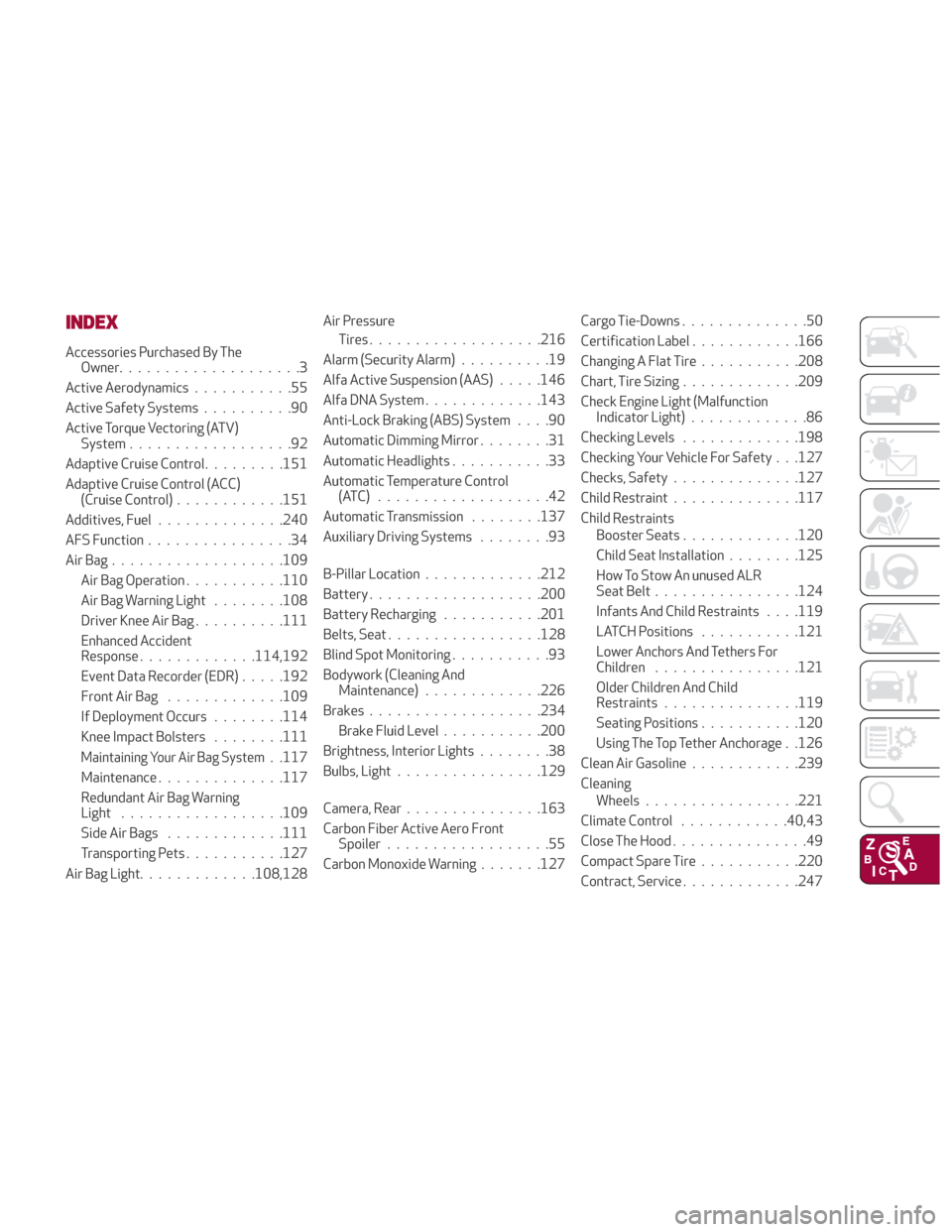
INDEX
Accessories Purchased By TheOwner....................3
Active Aerodynamics ...........55
Active Safety Systems ..........90
Active Torque Vectoring (ATV) System ..................92
Adaptive Cruise Control .........151
Adaptive Cruise Control (ACC) (Cruise Control) ............151
Additives, Fuel ............. .240
AFS Function ................34
AirBag.................. .109
Air Bag Operation ...........110
Air Bag Warning Light ........108
Driver Knee Air Bag ..........111
Enhanced Accident
Response .............114,192
Event Data Recorder (EDR) .....192
Front Air Bag .............109
If Deployment Occurs ........114
Knee Impact Bolsters ........111
Maintaining Your Air Bag System. .117
Maintenance ............. .117
Redundant Air Bag Warning
Light ................. .109
Side Air Bags .............111
Transporting Pets ...........127
Air Bag Light .............108,128 Air Pressure
Tires .................. .216
Alarm (Security Alarm) ..........19
Alfa Active Suspension (AAS) .....146
Alfa DNA System .............143
Anti-Lock Braking (ABS) System ....90
Automatic Dimming Mirror ........31
Automatic Headlights ...........33
Automatic Temperature Control (ATC) ...................42
Automatic Transmission ........137
Auxiliary Driving Systems ........93
B-Pillar Location .............212
Battery .................. .200
Battery Recharging ...........201
Belts, Seat ................ .128
Blind Spot Monitoring ...........93
Bodywork (Cleaning And Maintenance) .............226
Brakes .................. .234
Brake Fluid Level ...........200
Brightness, Interior Lights ........38
Bulbs, Light ............... .129
Camera, Rear .............. .163
Carbon Fiber Active Aero Front Spoiler ..................55
Carbon Monoxide Warning .......127Cargo Tie-Downs
..............50
Certification Label ............166
Changing A Flat Tire ...........208
Chart, Tire Sizing .............209
Check Engine Light (Malfunction Indicator Light) .............86
Checking Levels .............198
Checking Your Vehicle For Safety . . .127
Checks, Safety ..............127
Child Restraint ..............117
Child
Restraints
Booster Seats .............120
Child Seat Installation ........125
How To Stow An unused ALR
Seat Belt ............... .124
Infants And Child Restraints . . . .119
LATCH Positions ...........121
Lower Anchors And Tethers For
Children ............... .121
Older Children And Child
Restraints .............. .119
Seating Positions ...........120
Using The Top Tether Anchorage . .126
Clean Air Gasoline ............239
Cleaning Wheels ................ .221
Climate Control ............40,43
Close The Hood ...............49
Compact Spare Tire ...........220
Contract, Service .............247
Page 256 of 260
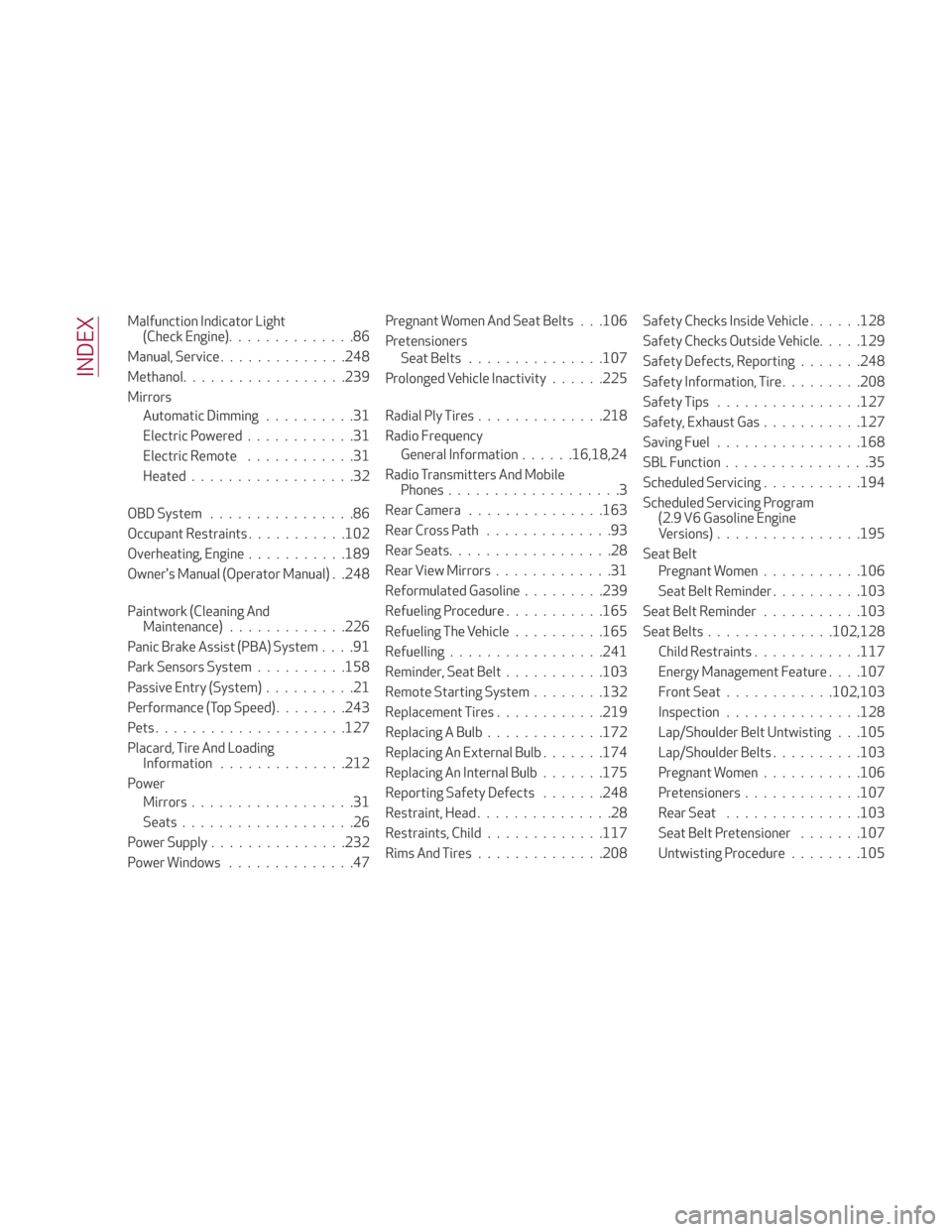
Malfunction Indicator Light(Check Engine) ..............86
Manual, Service ............. .248
Methanol ................. .239
Mirrors Automatic Dimming ..........31
Electric Powered ............31
Electric Remote ............31
Heated ..................32
OBD System ................86
Occupant Restraints ...........102
Overheating, Engine ...........189
Owner's Manual (Operator Manual) . .248
Paintwork (Cleaning And Maintenance) .............226
Panic Brake Assist (PBA) System ....91
Park Sensors System ..........158
Passive Entry (System) ..........21
Performance (Top Speed) ........243
Pets.................... .127
Placard, Tire And Loading Information ............. .212
Power Mirrors ..................31
Seats ...................26
Power Supply .............. .232
Power Windows ..............47 Pregnant Women And Seat Belts . . .106
Pretensioners
Seat Belts .............. .107
Prolonged Vehicle Inactivity ......225
Radial Ply Tires ............. .218
Radio Frequency General Information ......16,18,24
Radio Transmitters And Mobile Phones ...................3
Rear Camera .............. .163
Rear Cross Path ..............93
Rear Seats ..................28
Rear View Mirrors .............31
Reformulated Gasoline .........239
Refueling Procedure ...........165
Refueling The Vehicle ..........165
Refuelling ................ .241
Reminder, Seat Belt ...........103
Remote Starting System .......
.132
Replacement
Tires ............219
Replacing A Bulb .............172
Replacing An External Bulb .......174
Replacing An Internal Bulb .......175
Reporting Safety Defects .......248
Restraint, Head ...............28
Restraints, Child .............117
Rims And Tires ............. .208Safety Checks Inside Vehicle
......128
Safety Checks Outside Vehicle .....129
Safety Defects, Reporting .......248
Safety Information, Tire .........208
Safety Tips ............... .127
Safety, Exhaust Gas ...........127
Saving Fuel ............... .168
SBL Function ................35
Scheduled Servicing ...........194
Scheduled Servicing Program (2.9 V6 Gasoline Engine
Versions) ............... .195
Seat Belt Pregnant Women ...........106
Seat Belt Reminder ..........103
Seat Belt Reminder ...........103
Seat Belts ............. .102,128
Child Restraints ............117
Energy Management Feature . . . .107
Front Seat ............102,103
Inspection .............. .128
Lap/Shoulder Belt Untwisting . . .105
Lap/Shoulder Belts ..........103
Pregnant Women ...........106
Pretensioners .............107
Rear Seat .............. .103
Seat Belt Pretensioner .......107
Untwisting Procedure ........105
INDEX
Page 257 of 260
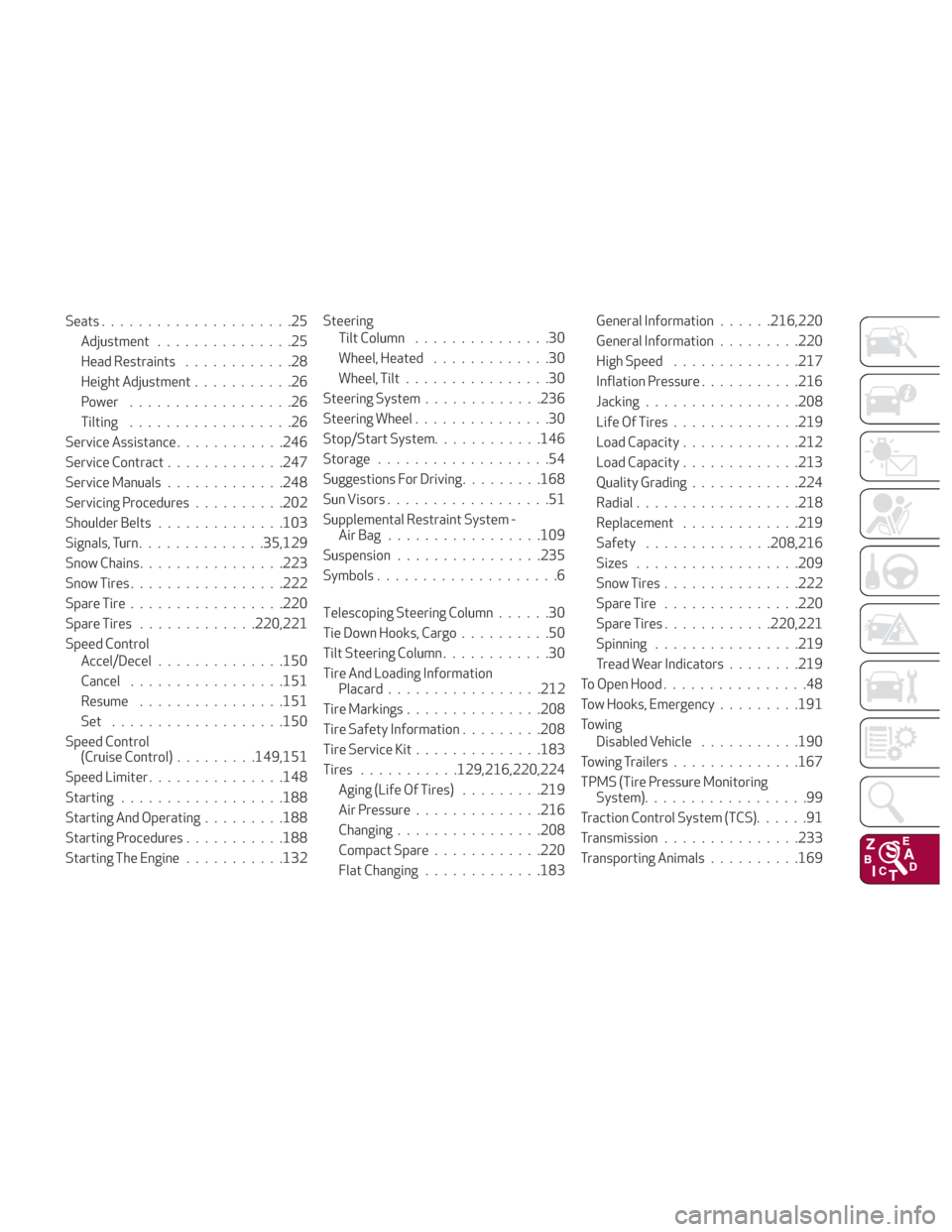
Seats.....................25
Adjustment ...............25
Head Restraints ............28
Height Adjustment ...........26
Power ..................26
Tilting ..................26
Service Assistance ............246
Service Contract .............247
Service Manuals .............248
Servicing Procedures ..........202
Shoulder Belts ............. .103
Signals, Turn ............. .35,129
Snow Chains ............... .223
Snow Tires ................ .222
Spare Tire ................ .220
Spare Tires .............220,221
Speed Control Accel/Decel ............. .150
Cancel ................ .151
Resume ............... .151
Set .................. .150
Speed Control (Cruise Control) .........149,151
Speed Limiter .............. .148
Starting ................. .188
Starting And Operating .........188
Starting Procedures ...........188
Starting The Engine ...........132 Steering
Tilt Column ...............30
Wheel, Heated .............30
Wheel, Tilt ................30
Steering System .............236
Steering Wheel ...............30
Stop/Start System ............146
Storage ...................54
Suggestions For Driving .........168
Sun Visors ..................51
Supplemental Restraint System - AirBag .................109
Suspension ............... .235
Symbols ....................6
Telescoping Steering Column ......
30
Tie Down Hooks, Cargo ..........50
Tilt Steering Column ............30
Tire And Loading Information Placard ................ .212
Tire Markings .............. .208
Tire Safety Information .........208
Tire Service Kit ............. .183
Tires ...........129,216,220,224
Aging (Life Of Tires) .........219
Air Pressure ............. .216
Changing ............... .208
Compact Spare ............220
Flat Changing .............183 General Information
......216,220
General Information .........220
High Speed ..............217
Inflation Pressure ...........216
Jacking ................ .208
Life Of Tires ..............219
Load Capacity .............212
Load Capacity .............213
Quality Grading ............224
Radial ................. .218
Replacement .............219
Safety ............. .208,216
Sizes ................. .209
Snow Tires .............. .222
Spare Tire .............. .220
Spare Tires ............220,221
Spinning ............... .219
Tread Wear Indicators ........219
To Open Hood ................48
Tow Hooks, Emergency .........191
Towing Disabled Vehicle ...........190
Towing Trailers ..............167
TPMS
(Tire Pressure Monitoring
System) ..................99
Traction Control System (TCS) ......91
Transmission .............. .233
Transporting Animals ..........169